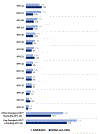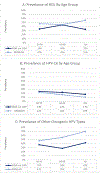Prevalence of Anal Human Papillomavirus Infection and Anal High-Grade Squamous Intraepithelial Lesions Among Men Who Have Sex With Men 50 Years and Older Living With or Without HIV
- PMID: 38985441
- PMCID: PMC11444595
- DOI: 10.1097/QAI.0000000000003450
Prevalence of Anal Human Papillomavirus Infection and Anal High-Grade Squamous Intraepithelial Lesions Among Men Who Have Sex With Men 50 Years and Older Living With or Without HIV
Abstract
Background: Anal cancer is caused by human papillomavirus (HPV), particularly HPV-16, and is preceded by anal high-grade squamous intraepithelial lesions (HSILs). The incidence of anal cancer is highest among men who have sex with men (MSM) living with HIV (MSMLWH) and increases with age. However, most previous studies of anal HPV infection and anal HSIL were performed on men under 50 years old, and relatively little is known about HSIL among older MSMLWH or MSM not living with HIV (MSM-Not-LWH).
Setting: We enrolled MSM who were aged 50+ during 2018-2022 in San Francisco, CA.
Methods: One hundred twenty-nine MSMLWH and 109 MSM-not-LWH participated. All participants had anal HPV DNA testing (Atila Biosystems) and high-resolution anoscopy with a biopsy of visible lesions.
Results: Among MSMLWH, 47% had anal HSIL, 19% had HPV-16, and 51% had other oncogenic anal HPV types (excluding HPV-16). Among MSM-not-LWH, 37% had anal HSIL, 22% had HPV-16, and 34% had other oncogenic anal HPV types. Increasing age was not statistically associated with prevalent HSIL, HPV-16, or other oncogenic HPV infections in MSMLWH or MSM-not-LWH. HPV-16 (odds ratio: 45.1, 95% confidence interval: 15.8-129); other oncogenic HPV types (odds ratio: 5.95, 95% confidence interval: 2.74-12.9) were associated with increased odds of anal HSIL, adjusted for age, income, education, and HIV status.
Conclusion: The prevalence of oncogenic anal HPV, anal HPV-16, and anal HSIL remains very high in older MSMLWH and MSM-not-LWH. With recent evidence showing that treating anal HSIL prevents anal cancer, MSM aged 50+ should be considered for anal cancer screening.
Copyright © 2024 Wolters Kluwer Health, Inc. All rights reserved.
Conflict of interest statement
The authors have no funding or conflicts of interest to disclose.
Figures


Similar articles
-
The natural history of anal high-grade squamous intraepithelial lesions among MSM and transgender women in an acute HIV cohort in Thailand.AIDS. 2025 Sep 1;39(11):1641-1649. doi: 10.1097/QAD.0000000000004238. Epub 2025 May 20. AIDS. 2025. PMID: 40387542 Free PMC article.
-
High Prevalence of Anal High-Grade Squamous Intraepithelial Lesions, and Prevention Through Human Papillomavirus Vaccination, in Young Men Who Have Sex With Men Living With Human Immunodeficiency Virus.Clin Infect Dis. 2021 Oct 20;73(8):1388-1396. doi: 10.1093/cid/ciab434. Clin Infect Dis. 2021. PMID: 33991185 Free PMC article.
-
Prevalence and incidence of anal high-grade squamous intraepithelial lesions in a cohort of cisgender men and transgender women who have sex with men diagnosed and treated during acute HIV acquisition in Bangkok, Thailand.J Int AIDS Soc. 2024 May;27(5):e26242. doi: 10.1002/jia2.26242. J Int AIDS Soc. 2024. PMID: 38695517 Free PMC article.
-
Anal human papillomavirus infection and associated neoplastic lesions in men who have sex with men: a systematic review and meta-analysis.Lancet Oncol. 2012 May;13(5):487-500. doi: 10.1016/S1470-2045(12)70080-3. Epub 2012 Mar 23. Lancet Oncol. 2012. PMID: 22445259
-
Epidemiology of anal human papillomavirus infection and high-grade squamous intraepithelial lesions in 29 900 men according to HIV status, sexuality, and age: a collaborative pooled analysis of 64 studies.Lancet HIV. 2021 Sep;8(9):e531-e543. doi: 10.1016/S2352-3018(21)00108-9. Epub 2021 Jul 30. Lancet HIV. 2021. PMID: 34339628 Free PMC article.
Cited by
-
Advances in human papillomavirus detection for cervical cancer screening and diagnosis: challenges of conventional methods and opportunities for emergent tools.Anal Methods. 2025 Feb 13;17(7):1428-1450. doi: 10.1039/d4ay01921k. Anal Methods. 2025. PMID: 39775553 Free PMC article. Review.
-
HPV and Cervical Cancer-Biology, Prevention, and Treatment Updates.Curr Oncol. 2025 Feb 22;32(3):122. doi: 10.3390/curroncol32030122. Curr Oncol. 2025. PMID: 40136326 Free PMC article. Review.
References
-
- National Cancer Institute. Surveillance, Epidemiology, and Ende Results Program. SEER*Explorer. Accessed July 25, 2022. https://seer.cancer.gov/statistics-network/explorer/application.html?sit...
Publication types
MeSH terms
Grants and funding
LinkOut - more resources
Full Text Sources
Medical

